A Detailed Guide on What is Sustainable Packaging!
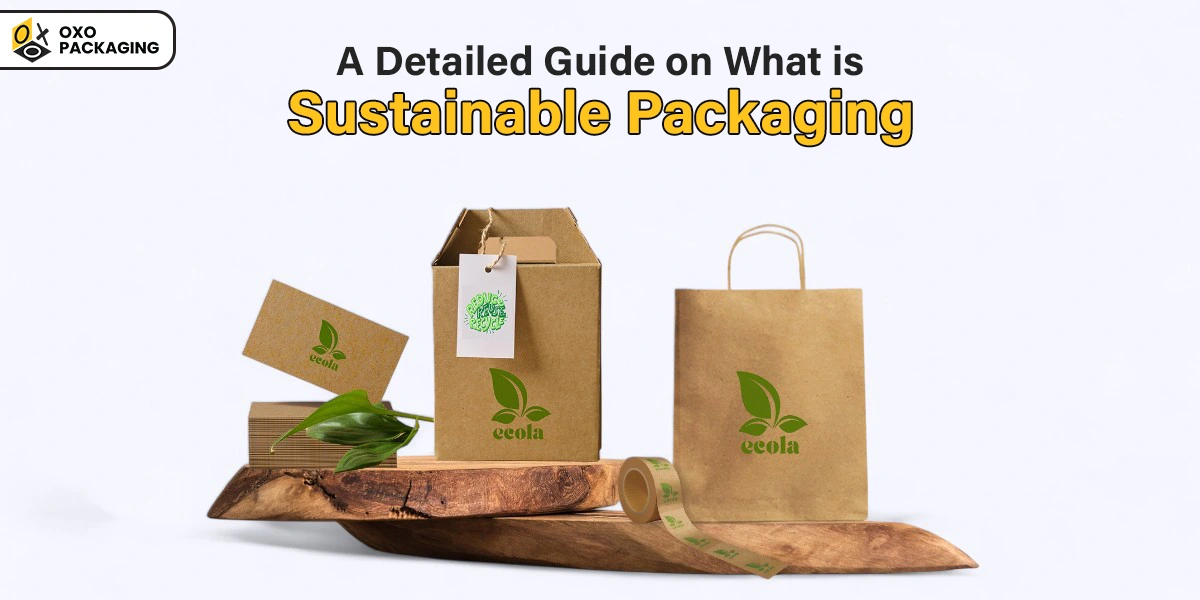
Consumers of the modern-day world are becoming more aware than ever about environmental consciousness in recent years. They are willing to pay more for eco-friendly products. Research studies show 80% of customers show a willingness to pay for products made from sustainable materials.
To attract eco-conscious customers, smart businesses are starting to adopt sustainable practices. Read this blog to get a better understanding of what is sustainable packaging and how you can leverage it to elevate your business!
What is Sustainable Packaging?
Sustainable packaging is a type of packaging that utilizes eco-friendly materials to pack, store, ship, or display products. There are different types of sustainable packaging, including compostable, recyclable, and biodegradable materials.
The most popular type of sustainable packaging is compostable. The best thing about compostable packaging is that it protects food products like regular packaging. It exhibits the properties and resilience of conventional materials but breaks down naturally in soil into beneficial organic compost.
What are Sustainable Packaging Materials?
Various types of sustainable packaging materials come under multiple categories. The four main categories include recyclable, biodegradable, compostable, and reusable. Let’s explore them:
Compostable and Biodegradable Materials
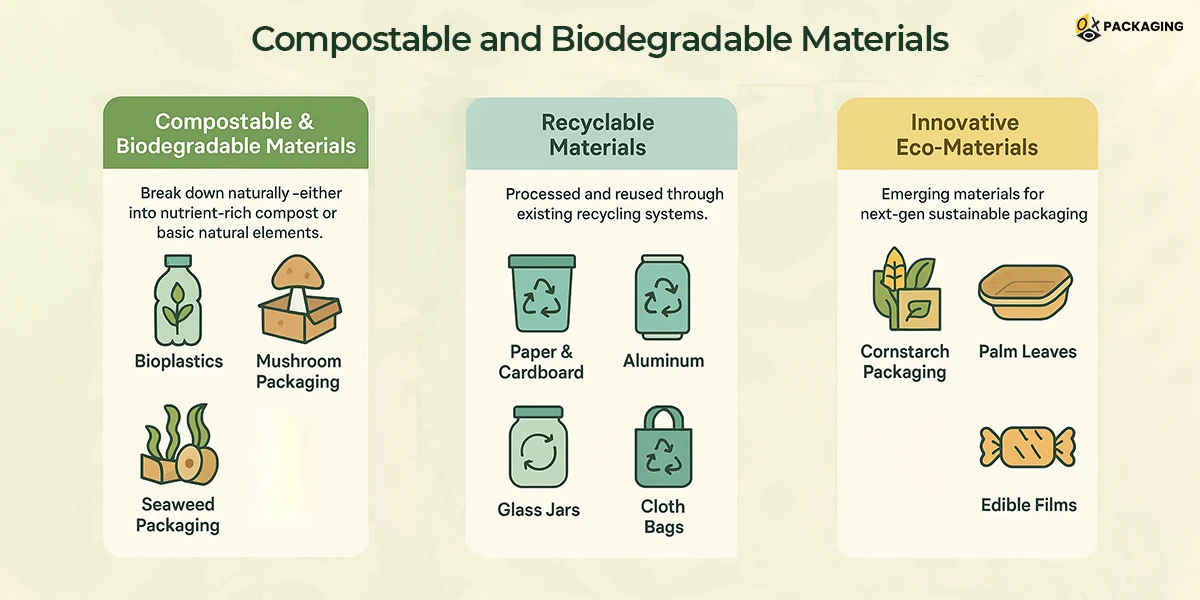
Both compostable and biodegradable materials decompose. However, compostable materials naturally break down into nutrient-rich soil (compost). Biodegradable materials break down into natural elements. The following materials come under the compostable and biodegradable categories:
-
Bioplastics: Offer a compostable alternative to conventional plastics. Because they are derived from renewable resources like cornstarch, sugarcane, or potato starch.
-
Mushroom Packaging: Serves as a renewable and compostable packaging solution, as it is made from mycelium, the root structure of mushrooms.
Seaweed Packaging: Used as a binder for plant waste to create packaging from agar. Agar is a substance derived from seaweed.
Recyclable Materials
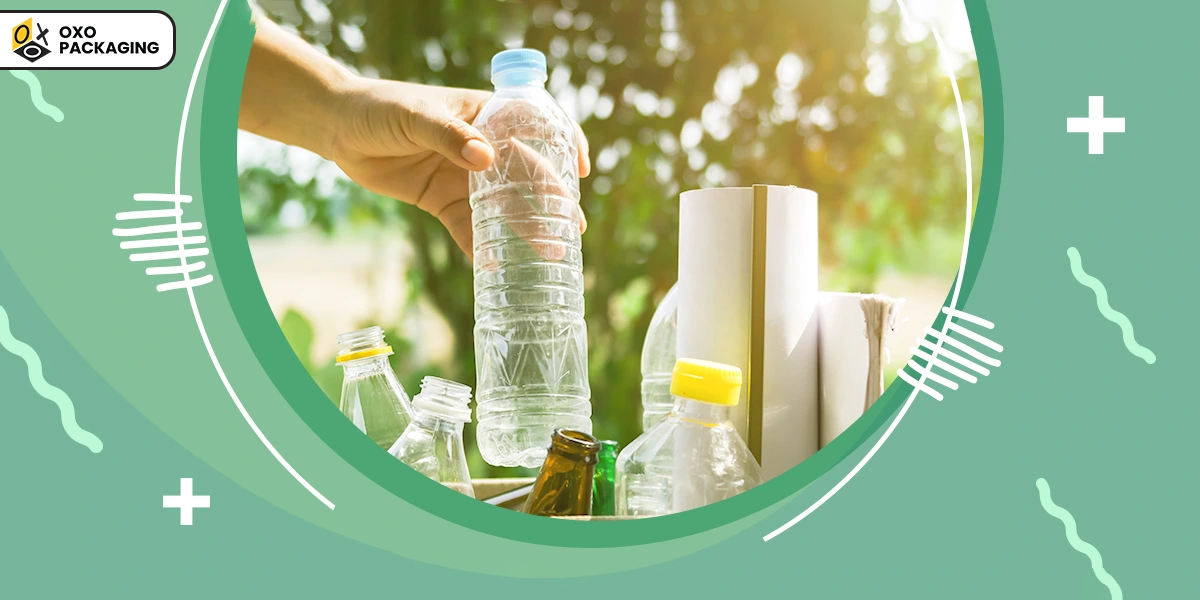
Recyclable materials are simply those materials that can be processed and repurposed to create new products. As a result, recyclable materials reduce waste and conserve resources while supporting environmental sustainability. The common examples of recyclable materials are:
- Paper and cardboard boxes: Readily recyclable and can be made from recycled content.
- Glass: Highly recyclable and can be recycled infinitely.
- Aluminum: Recyclable and can be recycled repeatedly.
- Certain plastics: Look for plastics with recycling symbols, like PET (polyethylene terephthalate) and HDPE (high-density polyethylene).
- Metal containers: Tin boxes and cans are durable and reusable.
Reusable Materials
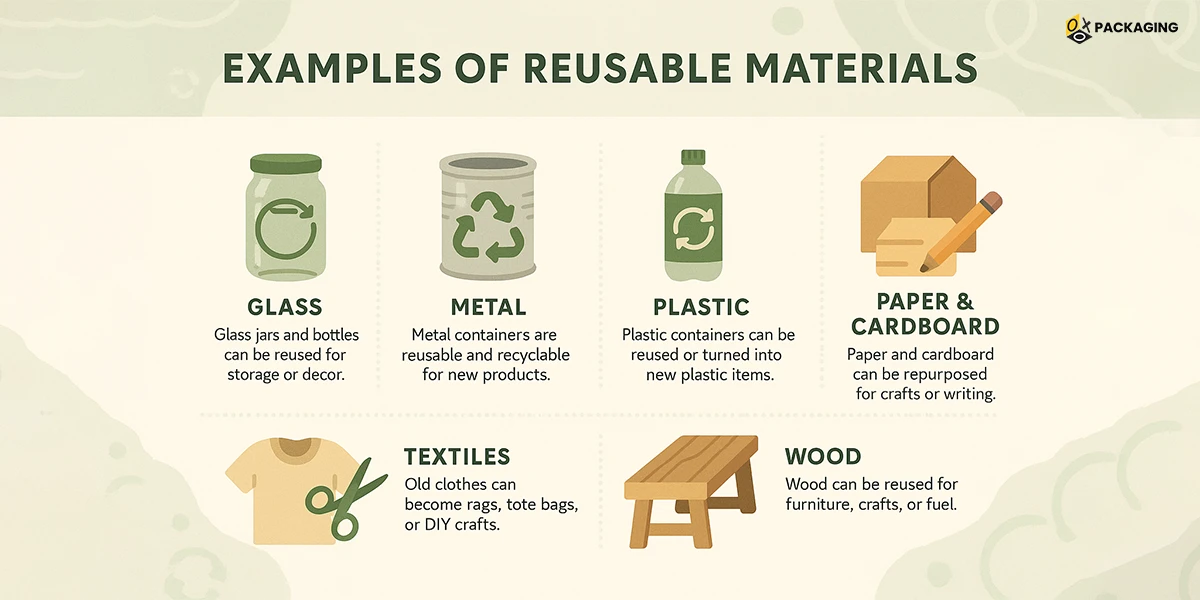
Reusable materials are those items that can be reused multiple times in their original form or repurposed into a new product. These materials also reduce environmental waste and promote green credentials. Examples of reusable materials are:
- Glass: Glass bottles and jars can be washed and reused for storage or transformed into decorative items.
- Metal: Metal cans and containers can be recycled and remade into new products or repurposed for storage or crafts.
- Plastic: Plastic bags, bottles, containers can be washed and reused for various purposes or recycled into new plastic items.
- Paper and Cardboard: Paper and cardboard can be used for crafts, notepads, or recycled into new paper products.
- Textiles: Old clothing and fabric scraps can be repurposed into cleaning rags, new items like custom zipper tote bags, or used for crafts.
Wood: Wood can be recycled for fuel, used in construction, or repurposed into furniture and other items.
Why Do We Need Eco-Friendly Packaging?
Only 23% of total PE films were sent for recycling in 2018, based on global surveys. As in 2023, the volume of plastic packaging worldwide reached 29.88 million tons. Based on past trends, the massive packaging is going to be garbage due to non-sustainable practices.
Hence, a significant rise in online shopping and e-commerce deliveries, low waste packaging requirement has become very crucial to maintain a delicate balance between packaging production and landfill waste accumulation.
|
|
||
|
89% |
85% |
78% |
|
Aussies are concerned about packaging waste
|
Americans and Britons are concerned about rising plastic packaging waste
|
Global consumers prefer compostable packaging as a preferred alternative to plastic packaging |
|
|
Choose Sustainable Packaging for Multiple Industries
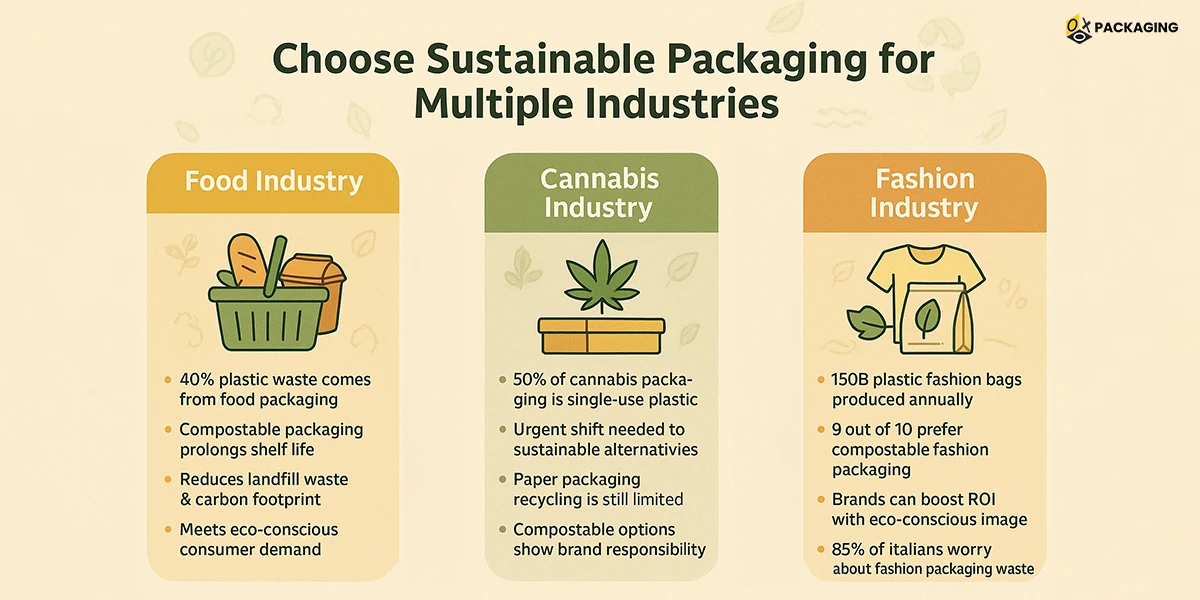
Almost no industry is safe from using plastic packaging, which results in waste accumulation in landfills and oceans. But top industries producing plastic packaging waste are food, cannabis, and fashion. Hence, these industries should adopt eco-friendly packaging to benefit the planet, business, and environment:
Food Industry
Incorporating sustainable practices in the food industry is a must. Let alone, 40% annual plastic waste comes from food packaging. Eco-friendly packaging not only reduces plastic pollution but also prolongs the shelf life of perishable items.
As a result, food businesses meet customer expectations, have a smaller carbon footprint, and reduce waste accumulation in landfills. Put simply, sustainable food packaging contributes to a healthier planet. Compostable materials keep food items safe as long as possible while significantly turning into nutrient-rich soil upon ending their lifetime.
Cannabis Industry
The cannabis industry heavily relies on single-use plastic packaging, which is used by more than half nowadays. It highlights the need for a shift towards sustainable packaging. The cannabis industry must adopt eco-friendly packaging to show its commitment to the green environment.
Although not all sustainable packaging solutions for this industry are suitable. Such as paper packaging often shows recycling challenges in America’s infrastructure. In addition to this, the quality of cannabis might be lower due to recycled paper packaging because it contains ink residues.
Fashion Industry
The fashion industry produces approximately 150 billion plastic packaging bags annually. Most of these bags end up in landfills and oceans. According to research, 85% of Italian adults show concern about clothing packaging waste.
9 out of 10 show willingness to receive clothing parcels in compostable bags. So clothing, fashion brands, or boutiques worldwide should invest in eco-friendly packaging to meet the expectations of eco-conscious customers. Doing so will not only build environmentally responsible behavior of brands but also boost their ROI.
Global Mission for Sustainable Packaging
Federal governments across the globe are taking steps to encourage sustainable packaging practices. America is one of those countries that has taken the initiative, like the “U.S. Plastics Pact,” to support environmental sustainability.
According to the U.S. Plastics Pact, multiple businesses, non-profits, government agencies, and research institutions are working towards a circular economy for plastics. Their vision is to eliminate unnecessary plastic packaging. And to make reusable, recyclable, or compostable packaging the norm while ensuring all plastic packaging is kept in the economy and out of the environment.
Apart from America, other countries, including Ireland, Italy, and Japan, are leveraging businesses adopting compostable packaging with tax exceptions. All these measures are part of a global mission to encourage individuals and businesses to move to sustainable packaging.
Should You Opt for Compostable or Recyclable Material?
When it comes to choosing sustainable packaging materials, a common debate starts over whether to choose compostable or recyclable materials. Both materials reduce packaging waste, but the difference lies in their waste processing.
You should choose either one, depending on the specific item and local disposal options. However, recycling is generally preferred. While both contribute to a circular economy, recycling can often be more efficient and prevent contamination.
Compostable materials are ideal for food and garden waste. But not all compostable items are created equal, and some can contaminate recycling streams. Here are the pros and cons of both materials, which you can weigh to choose the right one for you:
Pros and Cons of Recyclable Materials
|
Pros |
Cons |
|
Reduces reliance on virgin materials.
|
Requires infrastructure for collection and processing. |
|
Conserves energy compared to producing new materials. |
It can be affected by contamination, reducing the quality of the recycled material. |
|
Can be recycled multiple times, extending the life cycle of the material. |
Not all items are truly recyclable, and recycling rates are low. |
Pros and Cons of Compostable Materials
|
|
|
|
Pros |
Cons |
|
Turns organic waste into nutrient-rich compost, improving soil health. |
Need specific conditions (temperature, moisture, etc.) to break down effectively. |
|
Reduces landfill waste. |
It can be slower than recycling. |
|
Can be done at home or commercially. |
Compostable plastics can contaminate recycling streams. |
|
Not all compostable items are created equal, and some may not break down in home compost. |
|
|
|
Why Should Businesses Use Eco-Friendly Packaging?
Now that you have explored deeply what is sustainable packaging, you should also know why small to large-scale businesses should opt for eco-friendly packaging. Let’s dive into that:
- To meet the expectations of eco-conscious consumers: Modern consumers are getting concerned about plastic packaging waste across the globe. Replace plastic packaging with compostable packaging to expand your customer base and boost ROI.
- To gain a competitive advantage in your industry: Smart brands are already producing eco-friendly materials to remain compliant with the green initiatives of international governments. The future belongs to brands indulged in green practices in the modern marketplace.
- To minimize the amount of microplastic dumps: Contribute to a cleaner, greener world while reducing the amount of harmful waste in municipal garbage dumps and minimizing the amount of microplastics that leach into our soil, seas, and bodies.
Take Your Business to Next Level with Sustainable Packaging
For packaging suppliers, brands, and retailers, high-performance, low-waste packaging is no longer a dream. Support a sustainable packaging solution without any disruption to your business by partnering with OXO Packaging. OXO Packaging creates the right and green solution for your business. Make our planet greener and healthier by adopting organic and compostable packaging with us.
Sustainable packaging design focuses on minimizing the negative environmental impact of packaging throughout its entire lifecycle, from production to disposal.
Sustainable packaging is important to minimize the waste accumulation in landfills and oceans while reducing the carbon footprint impact on the environment.
There are four main types of sustainable packaging materials. Biodegradable, compostable, reusable, and recyclable are among those materials.
Sustainable packaging is more expensive than traditional packaging due to raw material costs, limited scale production, and manufacturing challenges.




